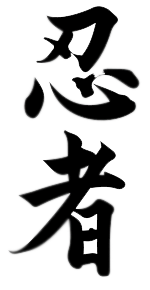
The main character Nin ( 忍 ) is composed of two greater characters. The upper character ha ( 刃 ) means "edge of the sword", and the lower character kokoro ( 心 ) means "heart" or "soul". The character 刀 means "sword" or "blade," the character 刃 means "edge of the sword." Together they mean "stealth", "secretness", "endurance", and "perseverance". Jutsu ( 術 ) means "art" or "technique". Pō ( 法 ) meaning "knowledge", "principle" when found with the prefix "nin" carries the meaning of ninja arts, higher order of ninjutsu. The popular view is that ninjutsu is only about secrecy and stealth. However, practitioners of this knowledge utilize it to endure all of life's hardships.
Ninjutsu was developed by groups of people mainly from the Iga Province and Kōka, Shiga of Japan. Throughout history the shinobi have been seen as assassins, scouts and spies. They are mainly noted for their use of stealth and deception. They have been associated in the public imagination with activities that are considered criminal by modern standards. Throughout history many different schools (ryū) have taught their unique versions of ninjutsu. An example of these is the Togakure-ryū. This ryū was developed after a defeated samurai warrior called Daisuke Togakure escaped to the region of Iga. Later he came in contact with the warrior-monk Kain Doshi who taught him a new way of viewing life and the means of survival (ninjutsu).
Ninjutsu was developed as a collection of fundamental survivalist techniques in the warring state of feudal Japan. The ninja used their art to ensure their survival in a time of violent political turmoil. Ninjutsu included methods of gathering information, and techniques of non-detection, avoidance, and misdirection. Ninjutsu can also involve training in disguise, escape, concealment, archery, medicine, explosives, and poisons.
Skills relating to espionage and assassination were highly useful to warring factions in feudal Japan. Because these activities were seen as dishonorable, Japanese warriors hired people who existed below Japan's social classes to perform these tasks. These persons were literally called "non-humans" ( 非人 hinin). At some point the skills of espionage became known collectively as Ninjutsu and the people who specialized in these tasks were called shinobi no mono.
In Japanese "Ninja Jūhakkei" that according to Bujinkan members the eighteen disciplines (jūhakkei < jūhachi-kei) were first stated in the scrolls of Togakure-ryū. Subsequently they became definitive for all Ninjutsu schools by providing total training of the warrior in various fighting arts and disciplines.
Ninja jūhakkei was often studied along with Bugei Jūhappan (the "18 samurai fighting art skills"). Though some are used in the same way by both samurai and ninja, other techniques were used differently by the two groups.
The 18 disciplines are:
Today the main focus of Ninjutsu deals with the techniques relevant to armed and unarmed combat.